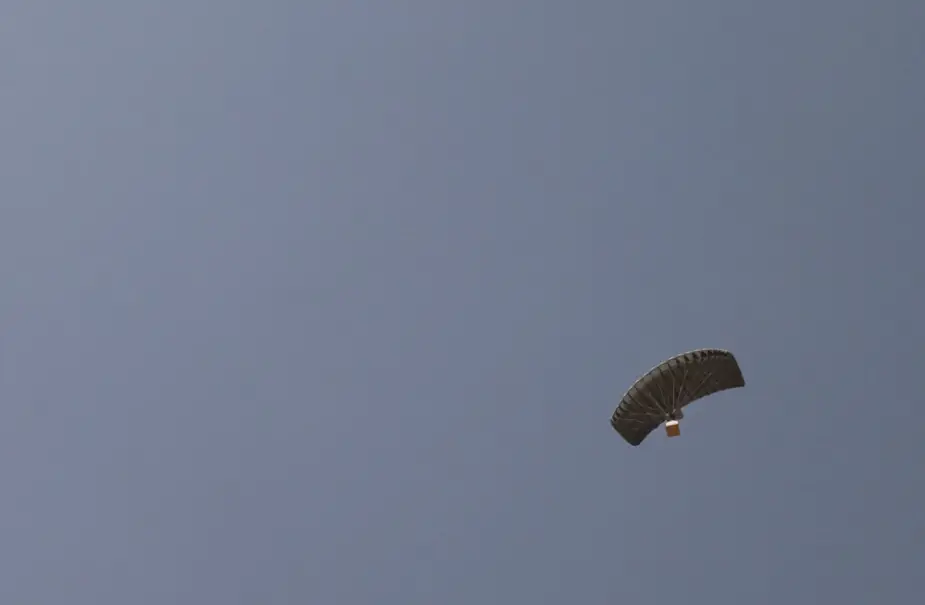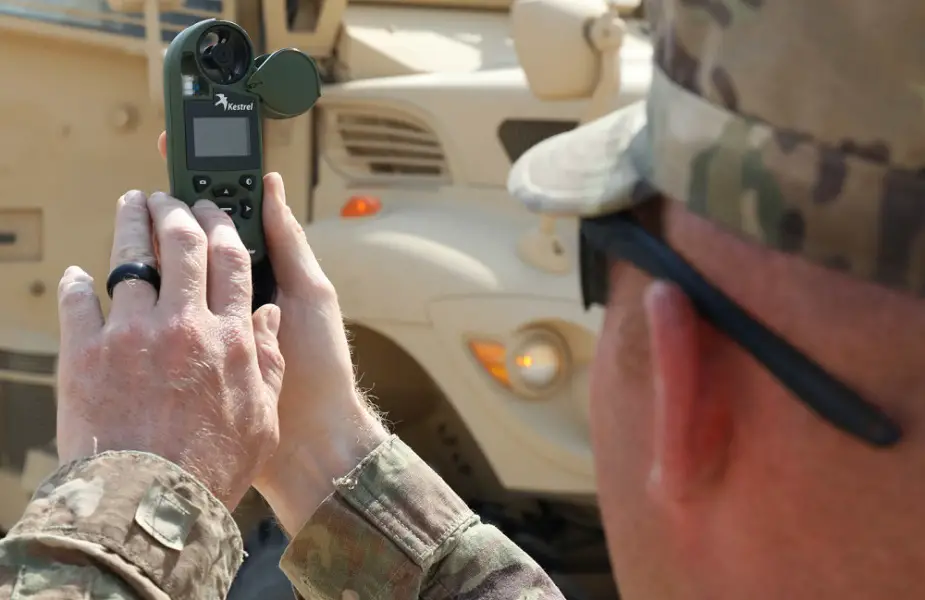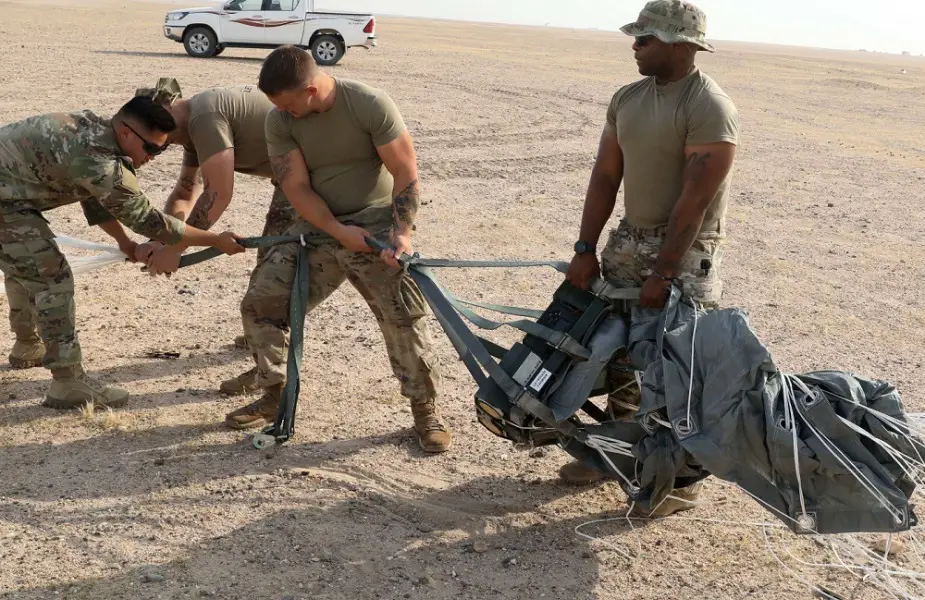Breaking news
Successful precision-airdrop GPS-guided pallets test in Kuwait.
Soldiers deployed to support 1st Theater Sustainment Command's logistical support of U.S. Central Command airdropped four pallets April 22 within 75 meters of the target here in a critical test of sustainment capabilities.
Follow Air Recognition on Google News at this link
 Soldiers deployed in support of 1st Theater Sustainment Command watch one of four bundles, guided by the Joint Precision Air Delivery System, touch down April 22, 2021 at the Camp Buerhring, Kuwait drop zone. Of the four bundles air dropped, all landed within 75 meters of the target, two landed within 25 meters and one landed within five meters (Picture source: US Army)
Soldiers deployed in support of 1st Theater Sustainment Command watch one of four bundles, guided by the Joint Precision Air Delivery System, touch down April 22, 2021 at the Camp Buerhring, Kuwait drop zone. Of the four bundles air dropped, all landed within 75 meters of the target, two landed within 25 meters and one landed within five meters (Picture source: US Army)
"This operation is the Joint Precision Air Delivery System and this was only the second drop we've executed in the CENTCOM area of responsibility in the last 18 months," said Lt. Col. Ryan Swedlow, the commander of the Fort Bliss, Texas, based 142nd Combat Sustainment Support Battalion.
"One of the challenges of the environment here is that as we get more geographically dispersed--how do we sustain those forces?" he said.
Sometimes forces are occupying locations where you do not want to send a convoy, he said. "Adding aerial delivery capability just gives us more options to extend our operational reach," he added. "We did the last one last year as a proof of principle; last time we dropped two systems," Swedlow said. "This time, we upped it to four."
Georgia National Guard Warrant Officer Michael Romeo, who is attached to 1st Theater Sustainment Command's operational command post at Camp Arifjan, Kuwait, said all four pallets landed within 75 meters of the Raised Angle Marker, or RAM, target. "Two landed within 25 meters and one landed within five meters," said Romeo, who works with Army Reserve Soldiers from the Indianapolis-based 310th Sustainment Command (Expeditionary) at the 1st TSC-OCP.
Romeo was at the drop zone to monitor operations as a subject matter expert or SME.
"Today, my role is to provide some supervision, some SME and experience, as well as getting to interact with the rigger company," said the airdrop system technician, who was in charge of the program for 1st TSC-OCP.
Swedlow said the ability to accurately airdrop supplies is a critical tool for commanders.
"What this capability allows us to do is put any commodity on the ground anywhere we need to with precision," the Lynchburg, Virginia, native said.
Swedlow said he gave the credit to his Soldiers for the excellent execution of the airdrops, which were carried and dispatched by a Marine-crewed C-130 aircraft.
"It's amazing to see the results of our labor," he added.
"A lot of hard work went into this--these systems are encrypted, there's a lot of communications security that goes into it," he explained. "A lot of proficiency from our 92 Romeo parachute riggers--we have two detachments, one at Kuwait and one at Qatar that worked seamlessly together to make this operation successful."
 One of four bundles, airdropped April 22, 2021 by 1st Theater Sustainment Command Soldiers using the Joint Precision Air Delivery system, hovers over the desert near Camp Buehring, Kuwait, drop zone before landing. The JPADS, using Modular Autonomous Guidance Unit, or MAGU, manipulates the parafoil's rigging to maneuver it towards the target (Picture source: US Army)
One of four bundles, airdropped April 22, 2021 by 1st Theater Sustainment Command Soldiers using the Joint Precision Air Delivery system, hovers over the desert near Camp Buehring, Kuwait, drop zone before landing. The JPADS, using Modular Autonomous Guidance Unit, or MAGU, manipulates the parafoil's rigging to maneuver it towards the target (Picture source: US Army)
The parachute riggers belong to the Fort Bragg, North Carolina-based 151st Quartermaster Company.
Rigger Spc. Andres Sanchez, 151st QM Company, said he was grateful for the chance to be a part of the airdrop.
"It was pretty cool to be able to watch something in action in a real-world situation," Sanchez said. "It's pretty cool because not only do you see it on paper, but you see it in real life."
The operations section noncommissioned officer-in-charge of the 142nd CSSB, Sgt. 1st Class Jeffrey Englehardt, who was the NCO running the drop zone said there are many conditions to watch for a JPADS drop.
"You have to make sure you got your recon done--and for someone doing it for the first time--you have to be familiar with the terrain, the wind speed, the weather we'll have," Englehardt said. "You have to make sure of your harnesses and all that," said the heavy transport operator, which is the military occupation code 88M.
As he waited for the C-130 to make its first pass of two bundles, the Ocala, Florida, native explained the rationale for constantly checking the wind.
"The wind is not too bad, there may be some gusts during our time on target," he said. "With our system that we're dropping today, any type of wind gust may miscalibrate the system--and it may steer off a little bit."
 Sgt. 1st Class Jeffrey Englehardt, the noncommissioned officer-in-charge of the operations section for the 142nd Combat Sustainment Support Battalion, which is deployed to support 1st Theater Sustainment Command, gauges wind speed near the Camp Buehring, Kuwait, drop zone for the April 22, 2021 air drop of four bundles using the Joint Precision Air Delivery System, JPADS. (Picture source: US Army)
Sgt. 1st Class Jeffrey Englehardt, the noncommissioned officer-in-charge of the operations section for the 142nd Combat Sustainment Support Battalion, which is deployed to support 1st Theater Sustainment Command, gauges wind speed near the Camp Buehring, Kuwait, drop zone for the April 22, 2021 air drop of four bundles using the Joint Precision Air Delivery System, JPADS. (Picture source: US Army)
Englehardt said because the drop was made from 6,000 feet he was not concerned. "It'll have plenty of time from the altitude it's being dropped at to re-adjust itself. If the parachute does not have a malfunction, it should have a slow descent of roughly 20 feet per second."
When the bundles leave the aircraft there is a moment when the Modular Autonomous Guidance Unit, or MAGU, gauges its position and steers the rectangular parafoil into a circle. The MAGU is positioned in the rigging between the parafoil and the payload.
"You'll see the bundle circle in motion as it triangulates itself to the point of impact," he said.
There is no external or remote control of the MAGU, which means it is immune to hacking or another compromise at a command or control site.
Qatar-based rigger Sgt. Cody Basinger, 151st QM Company, the supervisor for the airdrop systems, said, "After the bundles exit the aircraft, we're looking to see if the chute opens up and we stand back until it hits the ground, then we go to it and recover the equipment."
Englehardt said he was on the radio with the aircraft as it made its approach for the actual drops. "I was letting them know if the wind speeds were good and I've got to make sure the drop zone is clear and let the aircraft know if they are good to drop or not good to drop."
Looking over to the roughly one hundred camels corralled less than a mile away, he said there was another factor: "There's a lot of animals out on the drop zone."
Romeo said this airdrop was being followed by staff of the Quartermaster General and other parts of the Department of the Army.
"We've been planning this for about two-and-a-half, three months," Romeo said.
"Because of the system we're using, it always garners attention from Natick Labs, the guys in charge of developing, maintaining and improving this system," he said. Natick Labs is the legacy name for the innovations hub now called U.S. Army Natick Soldier Systems.
Romeo said he was thrilled for the opportunity to run the test here.
"Being able to use it out here in our area of responsibility--not necessarily in a conflict zone--but out here in Kuwait, it proves the purpose of having it."
"It is definitely better to test it out here," he said.
"You have a lot more space. One the issues we have back stateside--I can speak from experience--is when trying to use this system the failure footprint will fall into a residential area--it will fall out of restricted space, so that really limits where and when you can use this system--as well as the altitude you can drop it from," he said.
"Being out here with sand for miles in every direction--it is much easier to test at an operational altitude, as well as above that to higher altitudes," he said.
Swedlow said, "Every commander in charge of an air delivery is looking for good chutes, is looking for loads under the canopy and then it's just a matter of how close to the point of impact we hit."
 Riggers of the Fort Bragg, North Carolina, based 151st Quartermaster Company, deployed the U.S. Central Command area of responsibility in support of 1st Theater Sustainment Command, work to recover one of four Joint Precision Air Delivery System, or JPADS, units used to air drop four bundles at the Camp Buehring, Kuwait, drop zone. The black device rigged between the parafoil and the payload is the Modular Autonomous Guidance Unit, or MAGU, which uses the lines of the chute to steer it to its programmed target (Picture source: US Army)
Riggers of the Fort Bragg, North Carolina, based 151st Quartermaster Company, deployed the U.S. Central Command area of responsibility in support of 1st Theater Sustainment Command, work to recover one of four Joint Precision Air Delivery System, or JPADS, units used to air drop four bundles at the Camp Buehring, Kuwait, drop zone. The black device rigged between the parafoil and the payload is the Modular Autonomous Guidance Unit, or MAGU, which uses the lines of the chute to steer it to its programmed target (Picture source: US Army)

























